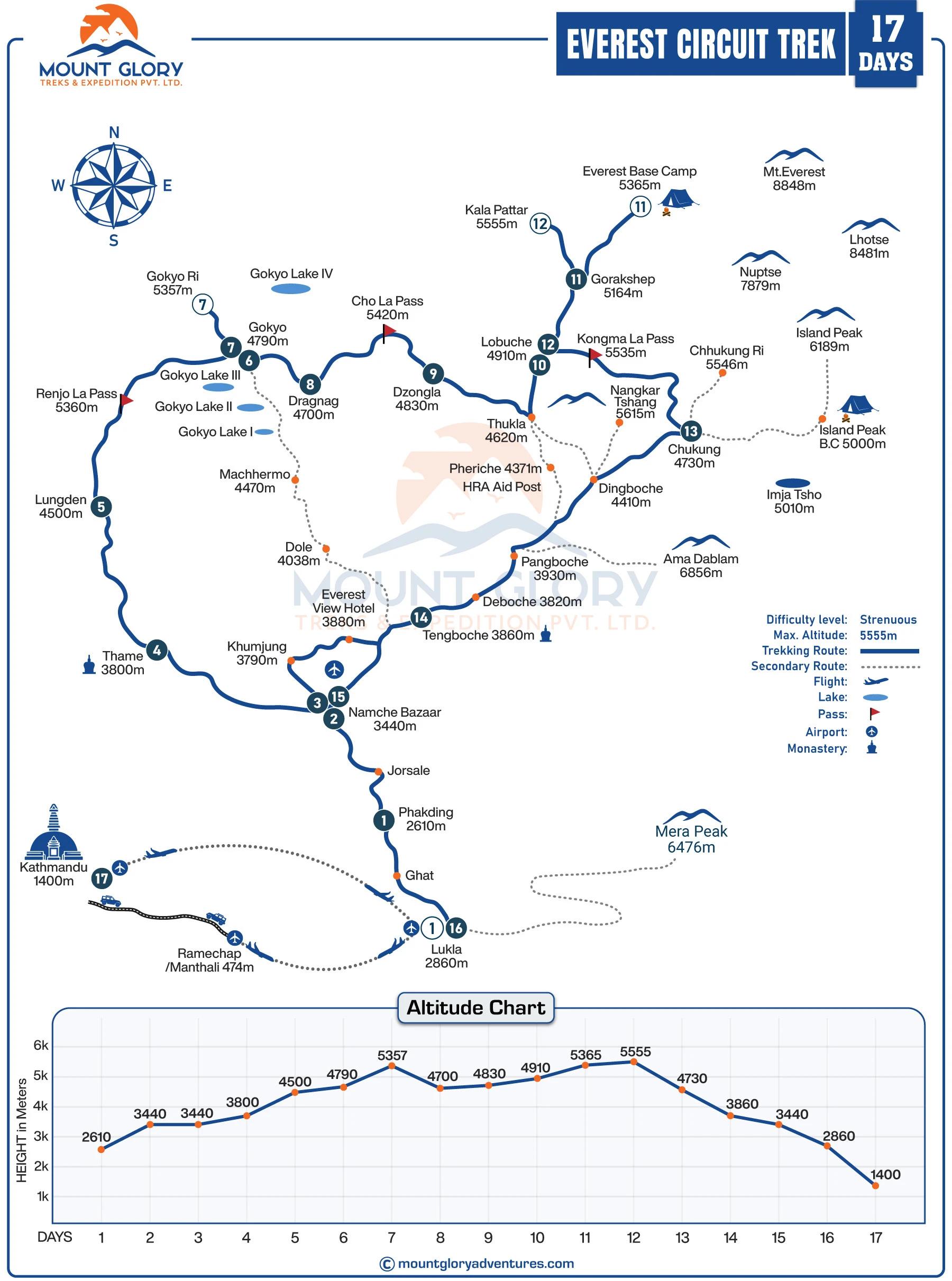The Everest Circuit Trek, also known as the Everest 3 Pass Trek, is an adventurous and challenging trip through the heart of the Khumbu Area in the Everest Region of Nepal. This journey provides a complete experience of the Rounded Everest Trek.
This Classic Everest Circuit Trek has been popular since 1953. It has become more popular around the world since the Sir Edmund Hillary and Tenzing Norge Sherpa climbs. Everest was inscribed on the UNESCO World Heritage Site List in 1979 as part of the Sagarmatha National Park (SNP). Annually more than 40,000 trekkers travel this great Everest Region Trail, and more than 1,000 climbers climb Mt. Everest(8848m).
Mount Everest Circuit Trekking is combined with the three high-altitude passes Kongma La Pass (5535 m), Cho La Pass (5420m), and Renjo La Pass (5465m). The hikers explore the marvelous views of beautiful peaks such as Mount Everest(8848m), Mount Nuptse, Mount Lhotse, Ama Dablam (6856m), Mount Makalu (8463m), and Shishapangma (8013m), which are located in the range of Great Himalayan Trail. The pathway also consists of visits to traditional Sherpa villages like Lukla, Namche Bazaar, Tengboche, and Dingboche, Lobuche where trekkers feel the local culture, festivals, traditions, and lifestyle.
The 17 Days Everest Round Trek will take you to a height of roughly 5555 m Kala Patthar which is the highest point in the route. it provides an interesting view of many 8000-m high peaks. This challenge will provide the rich Buddhist culture of the view of the Mani stone, monastery, and stupas. Tengboche Monastery is one of the most popular monasteries which lies on the Everest circuit trail. During the journey, trekkers pass the dense rhododendron forests of diverse colors and large white magnolia trees. The northern spring also gives mountaineers from around the world with their goal being to stand at the peak of Mt Everest 8848m.
The Everest Circuit Journey starts and ends from the gateway Lukla 2840 m which is one of the world's most adventurous thrilling flights. we will follow along the Dudh Khosi river floor, passing through farming villages of many mixed religious communities. After many days of trek, we will arrive at the base camp of the world's highest peak Mount Everest. This journey is clockwise or anti-clockwise. Mount Glory Treks designed the clockwise Everest Circuit Trekking 17 days itinerary based on the trekker’s satisfaction. But it is possible to do the anti-clockwise route as well.
The accommodation from the basic teahouses and lodges provides necessary meals to refuel for hiking. It is run by local families and provides Nepali meals like Dal Bhat along with more Western food.
The Everest Circuit Trek requires permits, which are Sagarmatha National Park permits, cost Nrs. 3000, and Khumbu Pasang Lhamu entry permits, cost Nrs. 2000. These permits are necessary to ensure the safety of the trekkers and the preservation of the local area. We have all the necessary permits which are included in our package.
In Conclusion, we designed Everest circuit trekking packages for our export at an affordable cost for 2024/2025. If you want to seize the challenging trekking experience in the Everest region this one is the perfect plan for novice and group trekkers. This trek is more strenuous compared with 14 days of regular Everest base camp trek.
How to Prepare for Everest Circuit Trekking in Nepal?
Round Everest Trip is an adventurous odyssey where you need both physical and mental preparation. This is more important in the trek is high altitude so consult a doctor before travelling.
Here are some tips before going to the Everest Circuit Trek
- Exercise like running, cycling, and swimming for 3 to 4 hours a day before the trek starts. You need to run an average distance of 8 km every day.
- Discuss the doctor for altitude sickness prevention, and medications before trekking in the high-elevations.
- Carrying your important materials like passport, visa, and other necessary documents during the trip.
- Packing high-quality trekking gear like boots, warm clothing, trekking poles, headlamps, water purification, and first-kit or personal medications.
- You must buy reliable travel insurance which should cover your emergency during the trek.
- Plan daily distances and altitudes to manage fatigue and acclimatization.
- Avoid alcohol and smoking during the trek. This reduces oxygen in the blood and stay hydrated drink 3-4 liters of water daily.
- You also research the food and accommodations in the Everest Region before the excursion.
Everest Circuit Trek Cost For 2024/2025
The exact cost of Everest Circuit Trek is USD 1550 per Person if 4 travelers travel together and the cost might reach up to USD 1750 if a solo traveler this means the price is not the same it depends on the number of travelers, guides, porters, food, accommodation, and other services.
Mount Glory Treks offers group breakdown cost details for Everest Circuit Trek in 2024/2025:
| No of Travelers | Cost Per Person | Inquiry |
| 1-1 | USD 1750 | Send Message |
| 2-3 | USD 1650 | Send Message |
| 4-6 | USD 1550 | Send Message |
| 7-9 | USD 1450 | Send Message |
| 10-12 | USD 1390 | Send Message |
Note: If your group size is more than 12 travelers you can directly contact us for a special group discount offer.






